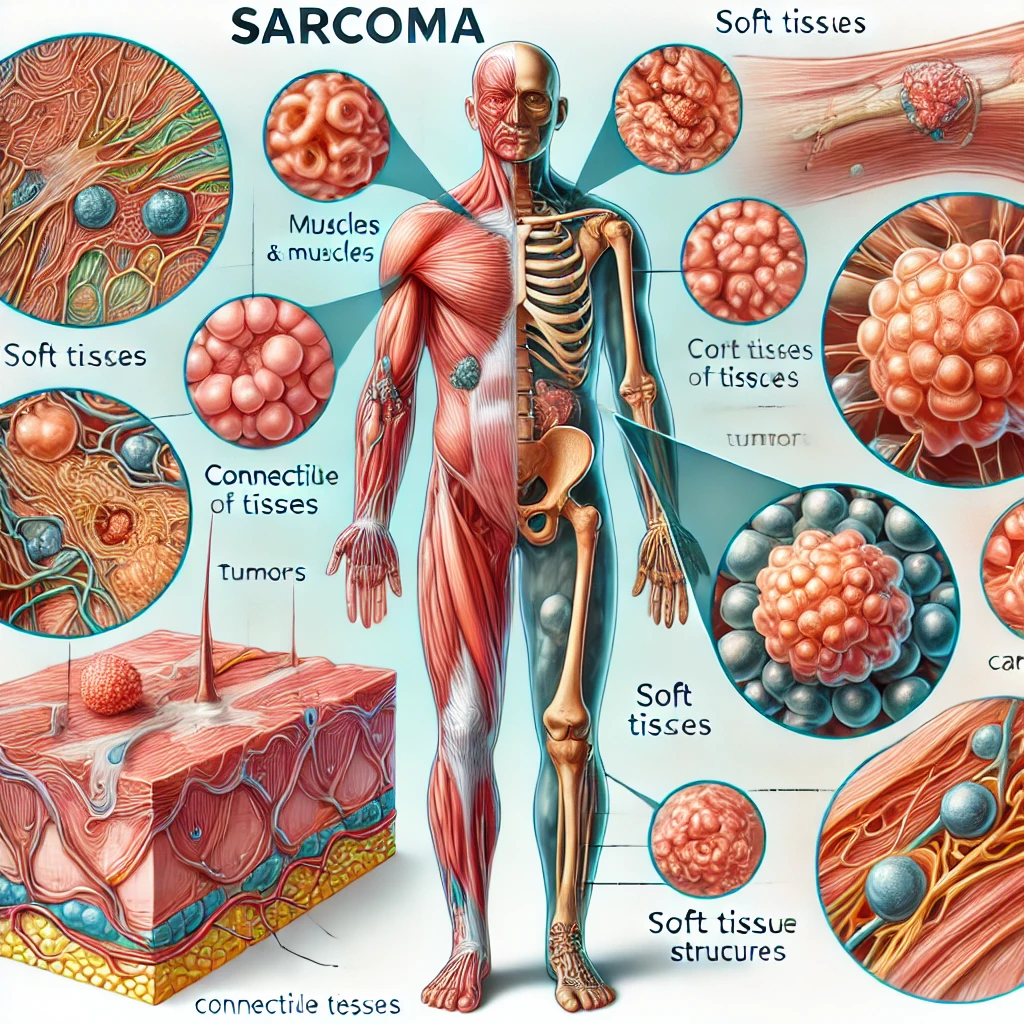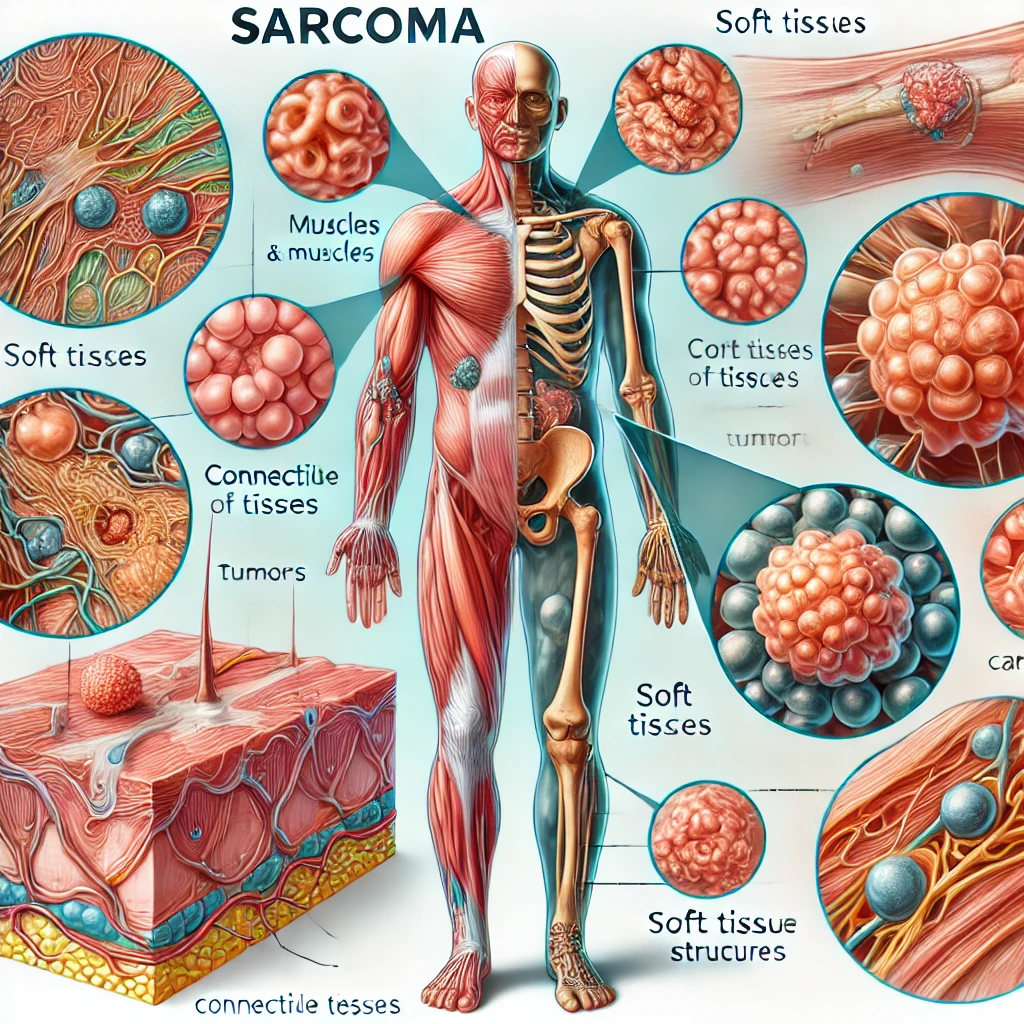Sarcoma is a rare form of cancer that develops in the body’s connective tissues, such as muscles, bones, nerves, and fat. While it’s relatively uncommon compared to other cancers, sarcoma is complex, with numerous subtypes. This article breaks down what sarcoma is, its symptoms, causes, and treatment options, ensuring a clear and friendly explanation.

What is Sarcoma?
Sarcoma refers to a group of cancers that originate in the connective tissues of the body. Unlike carcinomas, which start in organs like the lungs or breast, sarcomas develop in:
- Soft tissues (muscles, fat, nerves, blood vessels).
- Bones (osteosarcoma is a well-known subtype).
There are over 50 different subtypes of sarcoma, broadly categorized into two groups:
- Soft tissue sarcomas
- Bone sarcomas
Who is at Risk?
Sarcoma can affect anyone, but certain groups face higher risks:
- Children and young adults are more likely to develop specific types, such as Ewing sarcoma.
- Individuals with genetic conditions like Li-Fraumeni syndrome or neurofibromatosis.
- Radiation exposure during previous cancer treatments.
- Chemical exposure to substances like herbicides or dioxins.
Symptoms of Sarcoma
Sarcoma symptoms can vary depending on its location. Common warning signs include:
- Painless lumps or swelling in the soft tissues.
- Bone pain, which might worsen at night.
- Difficulty moving a limb if a tumor presses on joints or muscles.
- Unexplained weight loss and fatigue in advanced stages.
If you notice a persistent lump or unusual pain, consult a healthcare provider immediately.
How is Sarcoma Diagnosed?
Early detection is crucial. Diagnostic methods include:
- Imaging Tests
- MRI: Best for soft tissue sarcomas.
- CT Scans: Useful for locating metastases.
- X-rays: Often the first step for suspected bone sarcoma.
- Biopsy
A tissue sample is taken and examined under a microscope to confirm the presence of cancer cells. - Genetic Testing
Identifies specific mutations that may guide treatment.
Treatment Options for Sarcoma
Treatment depends on the type, size, and stage of the sarcoma. Options include:
- Surgery
- Primary treatment for localized sarcomas.
- Aims to remove the tumor with clear margins.
- Radiation Therapy
- Often used before or after surgery to shrink tumors or prevent recurrence.
- Chemotherapy
- More effective for certain subtypes, like Ewing sarcoma.
- Targeted Therapy
- Drugs designed to target cancer-specific genes or proteins.
- Immunotherapy
- Boosts the body’s natural defenses to fight cancer.
Sarcoma in the USA
In the USA, approximately 13,000 new cases of sarcoma are diagnosed annually. Public awareness campaigns, like those by the Sarcoma Foundation of America, aim to educate communities about early detection and treatment advances.
Living with Sarcoma
Coping with sarcoma involves emotional, physical, and financial challenges. Support groups and resources, such as the American Cancer Society, can be a lifeline. Regular follow-ups are critical for managing side effects and detecting recurrences.
“Cancer is a word, not a sentence.” – John Diamond
Where to Learn More
For additional information about sarcoma, visit medicaltimes.io. Other trusted resources include:
- American Cancer Society (cancer.org)
- Mayo Clinic (mayoclinic.org)
- Sarcoma Foundation of America (curesarcoma.org)
Top 10 FAQs About Sarcoma
- What is sarcoma?
Sarcoma is a rare cancer of connective tissues, including muscles and bones. - How common is sarcoma?
It accounts for about 1% of adult cancers but is more common in children. - What are the main symptoms of sarcoma?
Painless lumps, swelling, or persistent bone pain. - Is sarcoma curable?
Early-stage sarcomas are often treatable with surgery and radiation. - What causes sarcoma?
The exact cause is unknown, but genetic factors and chemical exposure play a role. - How is sarcoma diagnosed?
Through imaging tests, biopsies, and sometimes genetic testing. - What are the main treatments?
Surgery, chemotherapy, radiation, and targeted therapy. - Can sarcoma spread?
Yes, it can metastasize to other organs, particularly the lungs. - Are there support groups for sarcoma patients?
Yes, organizations like the Sarcoma Foundation of America provide support. - Where can I learn more?
Visit medicaltimes.io for expert insights and trusted articles.
